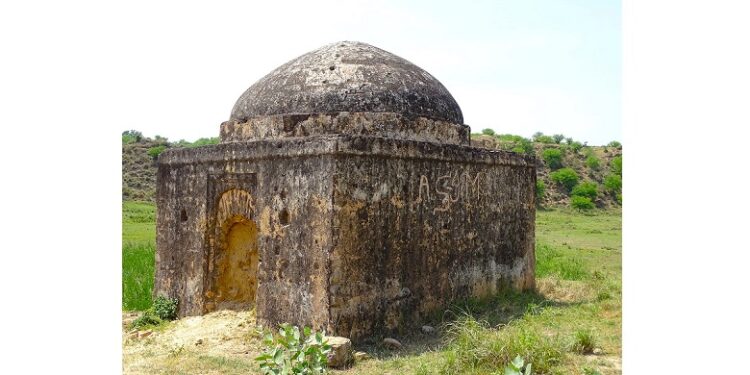
The rich Hindus, Jains, and Sikhs of Pothohar lavishly spent on the construction of the samadhis
Zulfiqar Ali Kalhoro
There are many historic villages in Rawalpindi’s Gujar Khan Tehsil. One such village is Bhagpur, which is located about 4 km north of Gujar Khan town. Not much is written about its history. The earliest source on the origin of the village is given by Raizada Brijnath in Waja Tasmia Dehat Dangali wa Pharwala. According to Raizada Brijnath, it was first founded by Bhagu/Bhago after whom the village was named Bhagpur. Later, one Kala Mal Khatri who was a resident of Pargana Rohtas, settled in Bhagpur. Raizada Brijnath believes that Kala Mal was from the Phul lineage of the Khatri caste, hence Bhagpur was also known as Bhagpur Phulan. It is said that the ancestors of Kala Mal Khatri served as Kardars of the Gakhars Rais of Pharwala and Dangali who bestowed the jagir of Bhagpur on Kala Mal Khatri.
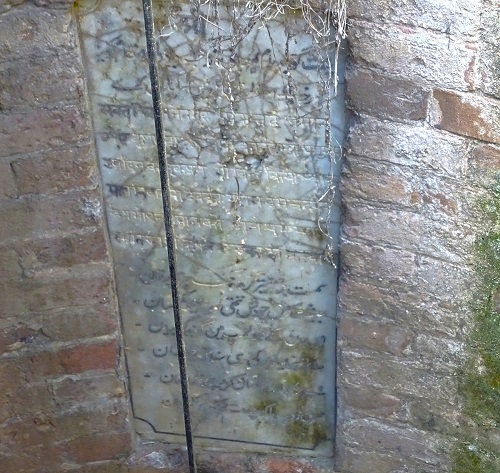
Bhagpur is also called Purna Bhagpur. I visited the village several times and met a few oral historians and village intellectuals who know the oral history of the village. One of the oral historians is Sabir Hussain. I conducted an interview with him about the history and heritage of Bhagpur village. Sabir Hussain is a notable of the Janjua tribe who knows the oral history of Bhagpur village. He is 75 years old. He is a retired Hawaldar from Pakistan Army and later served as Sub-Inspector security in the Capital Development Authority (CDA), Islamabad. I share some excerpts from an interview with him in this article. Sabir Hussain still recalls the names of Sikhs and Hindus who were well-reputed businessmen and landlords of the village which he learned from his grandfather Jiwan Khan Janjua. He not only remembers the names of the Hindu merchants but also their Choubaras (mansions) which were located in and around the village bazaar. He also identifies the names of the shopkeepers whose shops were located in the Bazaar of Bhagpur village. He is the most knowledgeable person in the village.
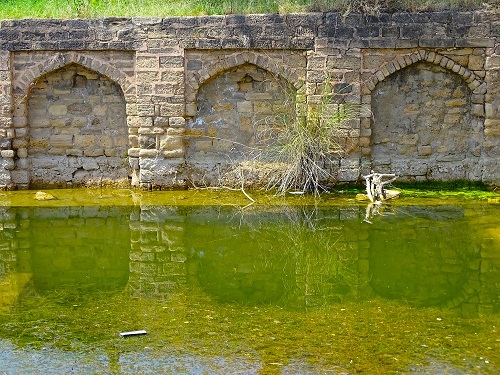
According to Sabir Hussain, Muslims, Hindus, and Sikhs lived in Bhagpur before the partition of 1947. Sikhs were in majority in the village. There was a bazaar in the village where the shops of both Hindus and Sikhs were located from where not only the residents of Bhagpur but also of the neighboring villages used to purchase items of daily use. He knows the names of a few Hindu merchants prominent amongst whom was Beli Ram. Prominent Sikhs of Bhagpur were Partab Singh, Jagta Singh, Gulab Singh, and others. A few Sikhs also owned agricultural land in Bhagpur village and near Dongi Dam. Bhagpur was dotted with choubaras (mansions) of both Hindus and Sikhs. The majority of the Choubaras were located in and around the village bazaar. There was a famous street of the Sonara Hindu community in the village which was called ‘Chhati Gali (covered street)’. The wooden ceiling of the street was ornately engraved.
Not a single Choubara has survived today. All of those have been either demolished or rebuilt
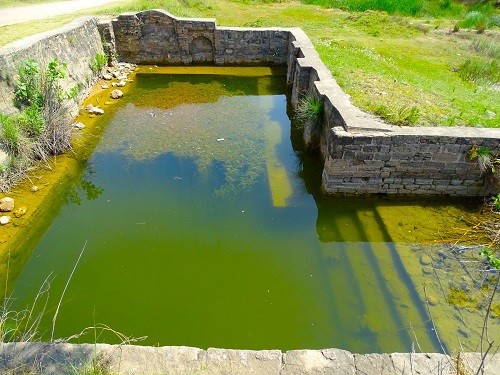
The porticoes of Choubaras of Bhagpur were noted for their ornamentation, which reflected the political and economic power of both Hindus and Sikhs in the area. Wooden doors were always flanked by sitting platforms, where once the older members of the family used to sit and observe the social and economic activities in a street, also received special treatment from the builders of the Choubaras of Bhagpur village. All the doors of the Choubaras were exquisitely carved.
Not a single Choubara has survived today. All of those have been either demolished or rebuilt. But Sabir Hussain informs that the majority of the Choubaras were noted for wooden balconies, jharokhas, and doors. Woodwork and stone were special architectural features of Choubaras in Bhagpur village.
Apart from Choubaras, Sabir Hussain also tells about the baolis, ban (water tanks), wells, shrines, temples, and samadhis in the village. He believes that there were about seven wells, two baolis (stepped wells), and two water tanks in the village. The main and most impressive baoli is located by road side along the bank of Sanghor Kas, a tributary of Nullah Kansi. Hindus used to take baths in the baoli. It was constructed of semi-masonry. One cannot find such baoli in the neighboring villages. Adjacent to this baoli is a well and dehri or samadhi of Hindu ascetic whose name Sabir Hussain does not know. It was a sacred place for both Hindus and Sikhs of Bhagpur and other neighboring villages.
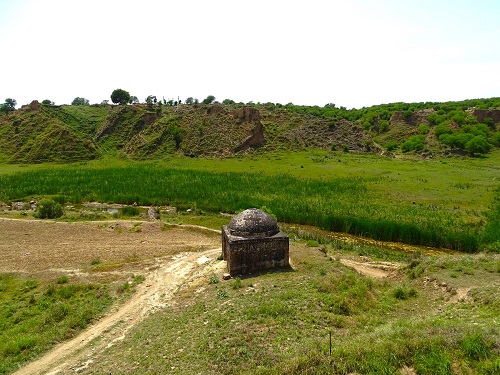
It is a square structure. Such square Samadhi is not found in any neighboring village. However, one can see a few Samadhis of Hindu and Sikh ascetics in other villages in Gujar Khan Tehsil. The most impressive and grand Samadhi, albeit in shambles, is located at Karnali village which belongs to Baba Mohan Das, an Udasi saint.
I have discussed Samadhis in Pothohar in my book Reflections on the Pothohar Heritage which was published in 2020 by Emel Publications, Islamabad that Pothohari samadhis assume two forms: square and octagonal. Square samadhis are located at Karnali, Dera Bakhshian, Gulyana, in Gujar Khan Tehsil, Domeli in Sohawa tehsil in Jhelum district, Kot Fateh Khan, Qutbal in Fateh Jang in Attock district and octagonal samadhis at Bhaun in Chakwal district, Kot Fateh Khan in Attock district, Bagh Sardaran in Rawalpindi town. All of these samadhis are adorned with paintings. Some of these are also decorated with glazed tiles. The distinctive features of Pothohari samadhis are ribbed domes and high-neck drums. Other distinctive features of these samadhis are nearby tanks and baolis (stepped wells) where the yatris (pilgrims) used to take baths during the time of the annual fair. The rich Hindus, Jains, and Sikhs of Pothohar lavishly spent on the construction of these samadhis.
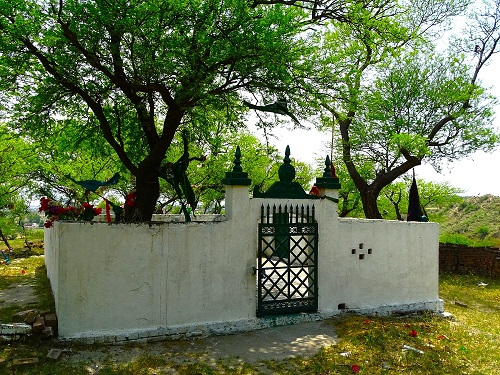
Samadhi at Bhagpur was painted from the inside. Apart from Samadhi, there also used to be a temple in Bhagpur village which was located opposite Samadhi and across the Sanghor Kas. Samadhi is located on the right bank of Sanghor Kas while the temple was situated on the left. The temple does not exist now.
Sabir Hussain also knows about wells that are located in different parts of the village. There is a well adjacent to the ban (water tank) near Government Boys Primary School that was built in the British period and recently rebuilt. The water tank has now disappeared but the well is still extant. There is a commemorative plaque on the wall of the well. Sabir Hussain believes that it was built in memory of a Hindu noble who died in the earthquake of 1935 in Quetta. It was probably built in memory of Pandit Gobind Ram as his name appears on the top of the commemorative plaque fixed on a wall of the well. To the north of the village was another well which was built by Hindus from where Muslims used to fetch water. There was also a baoli adjacent to the school that has disappeared now. To the south of the school was another well at a place which is locally called “Sheemay Wala Larr”. This well was also built by a Hindu noble of the village who was known as Sheema. There was also a well in the heart of the village which was called Sonaron Wala Kunwan (well of the Sonara community) as it was built by a Hindu noble from the Sonara community and was located in the Chhati Gali of Sonaras. This well is still extant and bears a donor plaque.
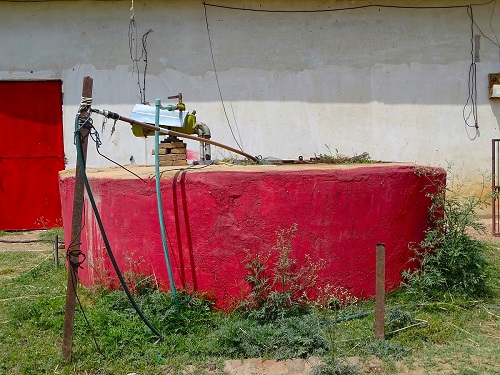
There are two popular shrines, including Baba Faiz Bakhsh and the bethak of Baba Jali Wali Sarkar in Bhagpur village, which are frequented by both Janjua Rajputs and Mughals. There are also shrines in Bhagpur Gujran, but the most popular is that of Baba Shamsuddin Qadiri, that is frequented and managed by the Gujjar community. After partition, Hindus and Sikhs left for India and the Mughals came from Kashmir and settled in Bhagpur village.
_______________________
About the Author
 Dr. Zulfiqar Ali Kalhoro, an anthropologist, has authored over 12 books in English and Urdu, including ‘Symbols in Stone: The Rock Art of Sindh’, ‘Perspectives on the art and architecture of Sindh’, ‘Memorial Stones: Tharparkar’ and ‘Archaeology, Religion and Art in Sindh’. He may be contacted at: zulfi04@hotmail.com
Dr. Zulfiqar Ali Kalhoro, an anthropologist, has authored over 12 books in English and Urdu, including ‘Symbols in Stone: The Rock Art of Sindh’, ‘Perspectives on the art and architecture of Sindh’, ‘Memorial Stones: Tharparkar’ and ‘Archaeology, Religion and Art in Sindh’. He may be contacted at: zulfi04@hotmail.com
Courtesy: The Friday Times Naya Daur Lahore (Posted on April 14, 2023)